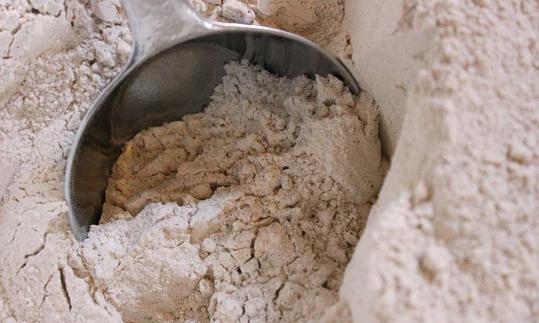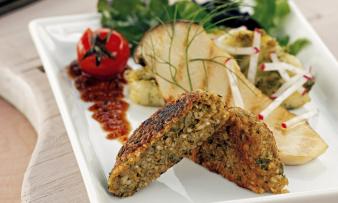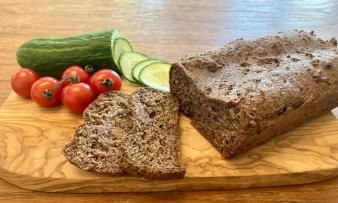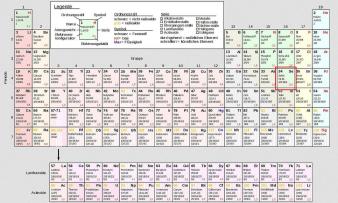Table of contents
Whole wheat flour ( raw, organic) consists of the entire wheat grain including the nutrient-rich shell and germ, making it rich in fiber, minerals and vitamins. Whole wheat flour is primarily used in baking.
Use in the kitchen
Wholemeal wheat flour (raw, organic) is darker and firmer than white wheat flour. Compared to white flour products, wholemeal products are heartier, more intense and somewhat nuttier in taste. Wholemeal wheat flour is used to make wholemeal bread and rolls, but wholemeal wheat flour is also used in pastries, cookies, pasta, cakes, waffles, pancakes, flans and quiches (e.g. wholemeal quiche with Brussels sprouts, sweet potatoes and orange). Wholemeal wheat flour can also be used in cooking (e.g. mixing roux, thickening sauces). When preparing pizza, tarte flambée, strudel and other desserts (e.g. Kaiserschmarrn), wholemeal wheat flour can easily replace white or semi-white wheat flour.
Doughs made from wholemeal flour have a firmer consistency than doughs made from white flour. Wholemeal dough rises less due to the high bran content. It is therefore advisable to use an additional raising agent or to mix the wholemeal wheat flour with other types of flour. When baking with wholemeal flour, the dough should be left to rest a little longer so that the shell parts can swell for longer. If you want to replace white flour with wholemeal flour, you should add 25% more liquid to the dough. Products made from wholemeal flour (eg wholemeal bread) stay fresh longer than white flour products.
Is wheat flour vegan? No animal products are used to produce whole wheat flour, just the wheat grain. Whole wheat flour is therefore a vegan food.
Homemade
Freshly ground wheat flour (whole grain) has a full flavor and is considered healthier and more nutritious than store-bought flour. Organic wheat grains can be purchased in health food stores, organic shops, organic supermarkets or online.
A grain mill or alternatively a mixer is suitable for making whole wheat flour. The grains should be ground on the finest setting at the lowest possible speed, otherwise the flour could heat up too much, which could cause nutrients to be lost. Pour the ground flour into an airtight container and store it in a dark, dry place.
Vegan recipe for whole wheat pancakes
Ingredients (for 2 people): 210 g whole wheat flour (organic), 300 ml oat milk, 2 tbsp plant-based yoghurt (e.g. soy yoghurt), 1 tbsp maple syrup, 2 tsp apple cider vinegar, 2 tsp baking powder, 1 tsp baking soda, 1 pinch of salt, a few berries (e.g.raspberries, strawberries,blueberries).
Preparation: Mix the wheat flour (whole grain), baking powder, baking soda and salt in a bowl. Add the oat milk, yogurt, maple syrup and apple cider vinegar and mix well with a mixer. Put 2-3 tablespoons of batter in a heated pan and fry. Turn the pancakes as soon as they start to bubble. Serve the finished whole grain wheat pancakes (vegan) with some soy yogurt, a few fresh berries and a little maple syrup.
Vegan recipes with wheat flour, whole grain can be found under the note: " Recipes that have the most of this ingredient ".
| Not only vegans or vegetarians should read this: Vegans often eat unhealthily. Avoidable nutritional errors. |
Purchasing - Storage
Whole wheat flour (raw) is available all year round in supermarkets such as Migros, Coop, Spar, Lidl, Rewe and Edeka. Other supermarkets such as Denner, Volg, Aldi, Hofer, etc. usually only offer whole wheat products. Organic shops, organic supermarkets ( Denn's Biomarkt, Alnatura) and online shops carry organic whole wheat flour (organic) in their range. Our recommendation: Choose regional products from organic farming (organic) to reduce the burden on the environment.
Be careful when buying whole grain products. Manufacturers often color them darker with sugar beet syrup, malt extract or caramel syrup to make them look "healthier". When buying, pay attention to terms such as whole grain or whole grain, because only if at least 90% whole grain is included can the manufacturer advertise its products with the term whole grain flour. 1
Storage tips
Whole wheat flour should be stored in a dark, dry and well-sealed place to avoid mold and pest infestation. Temperatures between 16 and 20 °C are ideal. Do not store whole wheat flour near foods with strong odors, such as tea, coffee or spices, as it can easily absorb foreign odors.
Flour loses its value when stored for a long time because, among other things, aromas evaporate and fiber reduces its ability to swell. Therefore, only buy as much flour as you can use in the near future. Whole wheat flour can be stored for a maximum of 6 months. The reason for this is the high protein and fat content in the germ, which promotes rancidity. If stored poorly, whole wheat flour can taste rancid after 3-4 weeks.
Ingredients - Nutritional values - Calories
100 g of raw whole wheat flour contains 340 kcal, which mainly come from carbohydrates. With 13 g/100g protein, whole wheat flour has more protein than wheat flour (12 g/100g) and whole corn flour (6.9 g/100g), but less than lupin flour (38 g/100g) and whole spelt flour (14 g/100g). The flour has a fat content of 2.5 g/100g. 2
The manganese content in whole wheat flour is high at 4.1 mg/100g. This covers 203% of the daily manganese requirement. Whole grain rice (4 mg/100g) and whole grain spelt flour (3.3 g/100g) achieve comparable values. Wheat germ contains significantly more manganese (13 mg/100g). 2
The 62 µg of selenium contained in 100 g of wheat flour (whole grain) cover 112% of the daily requirement. A similar amount of selenium is contained in couscous (66 µg/100g) and chia seeds (55 µg/100g). Black mustard (104 µg/100g) has an even higher proportion. 2
The amount of tryptophan in 100 g of whole wheat flour accounts for around 70% of the daily requirement. The content of 0.17 g/100g can be compared with oat flakes (0.18 g/100g) and whole spelt flour (0.16 g/100g). Shelled hemp seeds contain a particularly high amount of tryptophan (0.61 g/100g). 2
The complete ingredients of wheat flour, whole grain, coverage of the daily requirement and comparison values with other ingredients can be found in our nutrient tables below the ingredient picture.
Effects on health
Is wholegrain wheat healthy? Wholegrain wheat flour has a high fiber content. This makes wholegrain flour much more filling than white flour. The high fiber content reduces constipation, promotes the health of the stomach and intestinal tract and can also reduce the risk of cardiovascular disease, type 2 diabetes and certain types of cancer. 3 Blood pressure, blood sugar levels and cholesterol levels can also be regulated and lowered by eating wholegrain products. 4
Whole wheat flour contains many antioxidants. Antioxidants reduce oxidative stress by neutralizing free radicals. Oxidative stress leads to diseases such as cardiovascular disease, Parkinson's, Alzheimer's, hyperacidity, arteriosclerosis, diabetes and even cancer. 5
Whole wheat flour is rich in complex carbohydrates that the body must first break down and therefore keep you full for longer. The glycemic index (GI) of whole wheat flour is 40. Foods with a glycemic index below 50 are considered "good". A high glycemic index leads to a rapid increase in blood sugar levels. 6
Dangers - Intolerances - Side effects
Whole wheat flour contains the gluten protein. People who suffer from celiac disease (gluten intolerance) should definitely avoid eating products that contain wheat. Gluten-free alternatives are corn, whole grain rice, millet and pseudo-cereals such as buckwheat, quinoa and amaranth. 7
Even if you have a wheat allergy, you should avoid eating whole wheat products. The consumption of wheat triggers an immune reaction in those affected, in which antibodies form. These try to fight the protein contained in the wheat. Wheat allergies are more common in children, but they can improve as the immune system develops. A reaction to wheat in adulthood usually remains. Another well-known allergy is the so-called "baker's allergy", in which flour dust can trigger chronic rhinitis and asthma. 8
Whole grain products contain the secondary plant substance lectin. It serves as a defense against predators in the plant. Lectins fell into disrepute a few years ago because they are said to cause inflammation in the intestines, increase the permeability of the intestinal wall and disrupt the balance of the intestinal flora. However, lectins are only toxic in large quantities. With a balanced diet and normal consumption of whole wheat, there is no risk of toxicity from the secondary plant substance. 9
Folk medicine - natural medicine
Wholemeal wheat flour (organic, raw) is used in natural medicine in the form of poultices. With the help of moist, warm poultices made from the crumb of wheat bread, it is said that pus can be promoted in abscesses and thus the ripening process can be accelerated. 10 Cold poultices made from the crumb and vinegar can help with bruises and have a cooling effect.
Ecological footprint - animal welfare
The ecological CO 2 footprint of whole wheat flour is 0.84 kg CO 2 eq/kg. 14 The amount of water required to produce 1 kg of normal white flour is 1849 liters, the same amount as for producing 1 kg of wheat pasta and slightly more than is needed for the production of wheat alone (1827 liters). 15 Unfortunately, specific figures for whole wheat or white flour that allow a comparison between the types of flour are not available.
The most commonly grown type of wheat is the so-called "high-yield wheat", which is grown conventionally in monocultures. Although this produces high yields, it is very susceptible to pests and fungal infestation. Farmers therefore use a lot of pesticides and fertilizers, which seep into the groundwater and contaminate it. It is therefore better to use wheat flour made from organically grown wheat, as this does not use chemical pesticides and weeds are combated using mechanical work. Furthermore, growing 1 kg of organic wheat is said to produce around 60% fewer greenhouse gases than growing 1 kg of conventional wheat. 12
Targeted research is needed to anticipate future developments and changes in wheat cultivation as a result of global warming. The demands on cultivation and the corresponding adaptations vary from region to region - in lower latitudes, higher temperatures will occur in the future, accompanied by water shortages and droughts. In order to cultivate wheat in these areas, a heat and drought-resistant plant is required. In other regions, the increased temperatures may lead to an improvement in yield. 16
Worldwide occurrence - cultivation
In ancient Egypt, people first began to sift ground flour using nets. The resulting flour was coarser than white flour, but finer than wholemeal flour. Starting in Egypt, the art of baking bread spread through Greece and the Roman Empire to Europe. In the 17th century, wholemeal flour was considered rural and was intended for the lower classes, while white flour was reserved for the upper class. Before the Second World War, wholemeal wheat flour experienced a comeback, but the quality of wholemeal products declined sharply during the war due to resource shortages. In the 1950s, wholemeal flour was therefore frowned upon and the population once again turned to white wheat products. Wholemeal flour came back with the 1968 movement and became increasingly established in the 1970s. Today, products made from wholemeal flour are considered part of a healthy and balanced diet. People who pay attention to their diet value wholemeal products because of their healthy ingredients and filling properties. 11
For more information on the origin, occurrence, cultivation, harvest and ecology of wheat, see the articles Wheat grains and Wheat flour.
Further information
Whole wheat flour consists of the entire grain, minus the husk and husk. The wheat grain consists of three parts: the fruit and seed shell, the endosperm and the nutrient-rich germ. Wheat is rich in proteins, vitamins, fiber, minerals and complex carbohydrates. The nutrients are not evenly distributed throughout the grain, but are primarily found in the shell and germ, while the endosperm consists mainly of starch and protein. 2, 12
Whole wheat flour has the highest degree of milling at 100%. The higher the degree of milling, the more wheat grain it contains. 100 g of whole wheat flour is obtained from 100 g of wheat grain. Flour (whole wheat) is not classified. Depending on the year of harvest, size of the endosperm and growing area, the mineral content per 100 g is 1700-2000 mg. 13
Alternative names
You can also find spellings for wholemeal wheat flour such as wholemeal wheat flour, wholemeal wheat flour, wholemeal flour made from wheat. Even spelling mistakes such as wholemeal wheat flour, wholemeal wheat flour, wholemeal wheat flour, wholemeal wheat flour creep in.
In English, wheat flour (whole grain) is called wholemeal flour (UK) and whole-wheat flour (US). In Spanish, wheat flour, whole grain, is called harina de trigo integral.
Bibliography - 16 Sources
| 1. | Deutsches Institut für Normung e. V. DIN 10355, Mahlerzeugnisse aus Getreide. Berlin; 1991: 2. |
| 2. | USDA United States Department of Agriculture. |
| 3. | Roger JDP. Heilkräfte der Nahrung. Advent-Verlag: Zürich. 2006: 292-295. |
| 4. | Barrett EM, Batterham MJ, Ray S, Beck EJ. Whole grain, bran and cereal fibre consumption and CVD: a systematic review. Br J Nutr. 2019;121(8):914–37. |
| 5. | Tan BL, Norhaizan ME, Liew W-P-P. Nutrients and oxidative stress: friend or foe? Oxid Med Cell Longev. 2018;2018:9719584. |
| 6. | Diabetes-austria.com Glykämischer Index Weizenmehl, Vollkorn. |
| 7. | Smollich M, Vogelreuter A. Nahrungsmittelunverträglichkeiten: Lactose-Fructose-Histamin-Gluten. Verlag: Wissenschaftliche Verlagsgesellschaft: Stuttgart. 2. Auflage 2018. |
| 8. | Lebensmittelunvertraeglichkeiten.de Weizenallergie. |
| 9. | Van Buul VJ, Brouns FJPH. Health effects of wheat lectins: A review. Journal of Cereal Science. 2014;59(2):112–7. |
| 10. | Pflanzenfreunde.com Naturheilkunde Weizenmehl. |
| 11. | Planet-wissen.de Geschichte Vollkornweizenmehl. |
| 12. | Pini U. Das Bio-Food-Handbuch. Ullmann: Hamburg, Potsdam; 2014: 794-795. |
| 13. | Baeckerlatein.de Vollkornmehl. |
| 14. | CONCITO. The Big Climate Database, version 1. 2021. |
| 15. | Mekonnen MM, Hoekstra AY. The green, blue and grey water footprint of crops and derived crop products. Hydrol. Earth Syst. Sci. 2011; 15: 1577-1600. |
| 16. | Ortiz R, Sayre K, Goaverts B, et al. Climate change: Can wheat beat the heat? Agriculture, Ecosystems & Environment. 2008; 46-58. |











Comments